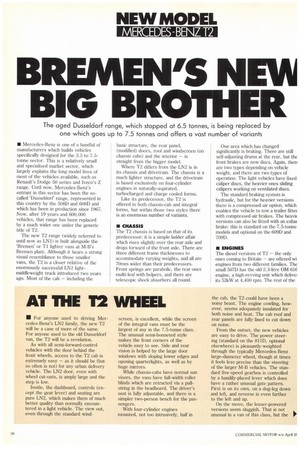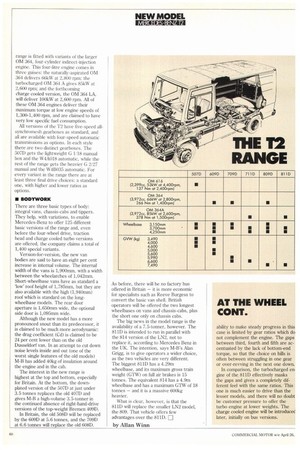AT THE 1'2 WHEEL
Page 58

Page 60

If you've noticed an error in this article please click here to report it so we can fix it.
• For anyone used to driving Mercedes-Benz's LN2 family, the new 12 will be a case of more of the same. For anyone used to the old Dusseldorf van, the 12 will be a revelation.
As with all semi-forward-control vehicles with the door behind the front wheels, access to the T2 cab is extremely easy — as it should be (but so often is not) for any urban delivery vehicle. The LN2 door, even with wheel cut-outs, is amply large and the step is low.
Inside, the dashboard, controls (except the gear lever) and seating are pure LN2, which makes them of much better quality than normally encountered in a light vehicle. The view out, even through the standard wind screen, is excellent, while the screen of the integral vans must be the largest of any in the 7.5-tonne class. The unusual semi-bonneted style makes the front corners of the vehicle easy to see. Side and rear vision is helped by the large door windows with sloping lower edges and opening quarterlights, as well as by huge mirrors.
While chassis-cabs have normal sun visors, the vans have full-width roller blinds which are retracted via a pullstring in the headboard. The driver's seat is fully adjustable, and there is a simpler two-person bench for the passengers.
With four-cylinder engines mounted, not too intrusively, half in the cab, the T2 could have been a noisy beast. The engine cowling, however, seems adequately insulated for both noise and heat. The cab roof and rear panels are fully lined to cut down on noise.
From the outset, the new vehicles are easy to drive. The power steering (standard on the 811D, optional elsewhere) is pleasantly-weighted through the typically Mercedes-Benz large-diameter wheel, though at times it feels less precise than the steering of the larger M-B vehicles. The standard five-speed gearbox is controlled by a handily-placed lever which does have a rather unusual gate pattern. First is on its own, on a dog-leg down and left, and reverse is even further to the left and up.
On the move, the lesser-powered versions seem sluggish. That is not unusual in a van of this class, but the ability to make steady progress in this case is limited by gear ratios which do not complement the engine. The gaps between third, fourth and fifth are accentuated by the lack of bottom-end torque, so that the choice on hills is often between struggling in one gear or over-revving in the next one down.
In comparison, the turbocharged en. gine of the 811D effectively masks the gaps and gives a completely different feel with the same ratios. This one is much easier to drive than the lesser models, and there will no doubt be customer pressure to offer the turbo engine at lower weights. The charge cooled engine will be introduced later, initially on bus versions.
































































